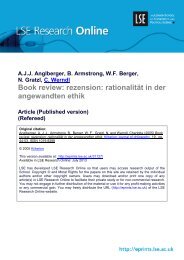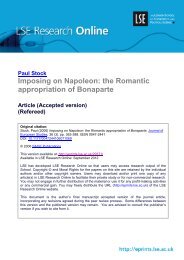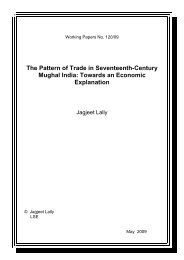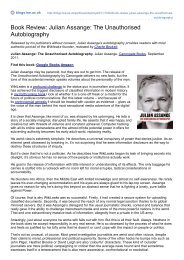Download (307Kb) - LSE Research Online
Download (307Kb) - LSE Research Online
Download (307Kb) - LSE Research Online
Create successful ePaper yourself
Turn your PDF publications into a flip-book with our unique Google optimized e-Paper software.
users for the purposes of sharing and exchange within communities of interest’<br />
(European Commission, 2010c: para 21). While the content produced by private<br />
individuals is outside this policy framework, other content production – regulated and<br />
unregulated – is seen as a key component of the European project of developing markets<br />
that can compete on the world stage. The audiovisual media sector is expected to<br />
contribute substantially to building a competitive European information society. As<br />
Pouwels and Donders (2011) point out, recent years have seen major changes in the<br />
focus of audiovisual policy in Europe. The media service provider is now defined as ‘the<br />
natural or legal person who has editorial responsibility for the choice of the audiovisual<br />
content of the audiovisual media service and determines the manner in which it is<br />
organised’ (European Commission, 2010c: Art 1d). This excludes, for the present,<br />
telecommunication operators, and the print and publishing industries, but all the<br />
commercial providers are seeking audiences and advertising or subscription revenues.<br />
Theoretically, they are all expected to compete on a level playing field, a field that should<br />
not be distorted by publicly supported organisations in the sector, that is, those charged<br />
with<br />
public interest obligations.<br />
This friction between the cultural and economic ambitions for the audiovisual media<br />
sector in Europe is captured in a European Commission discussion document on the<br />
development of the market for creative content in Europe. Here it is asserted that ‘the<br />
online distribution of creative content in the EU has the potential to create more choice<br />
and diversity for consumers, new business models for commercial users and more<br />
sustainable growth for rightholders’ (European Commission, 2009b: 1). The tension is<br />
between those who benefit from the relative scarcity of digital content which can be sold<br />
in the commercial market and citizens who may benefit from the broadest availability of<br />
such content in line with the information requirements of democratic societies. With the<br />
changes in the structure of audiovisual media industries over the past two or more<br />
decades, policies aimed at creating a competitive marketplace for audiovisual media,<br />
while preserving cultural diversity and safeguarding media pluralism, stand in<br />
contradiction<br />
to each other.<br />
Information Society Biases<br />
In the information society, competition is the predominant value. This is not surprising<br />
given the value of the information and communication technology (ICT) sector as a<br />
whole. Total ICT spending worldwide was estimated at USD 3,398 billion in 2009. North<br />
4
















